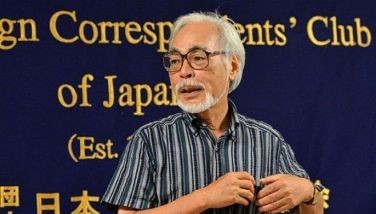Why Peter Pan is timeless entertainment
MANILA, Philippines - Local followers of Peter Pan remember fondly Disney’s 1953 full-length animated feature. The source of the movie, a play, was written half a century earlier (1904) by the Scottish author and playwright Sir James Matthew Barrie who gave the world Peter Pan, or The Boy Who Wouldn’t Grow Up. Other versions were created through the decades including a musical in the early ’70s for stage and television. Still not very clear to this writer is why for a long time, tradition dictated that an actress play the male title role, such as the elderly Mary Martin and the slightly androgynous Mia Farrow did.
Steven Spielberg retold the story in 1991 in the star-studded, big-budgeted fiasco Hook, casting the very male but very mature Robin Williams as Peter (obviously a grownup and a father, too), with Dustin Hoffman in the title role, Julia Roberts, Maggie Smith and the Filipino child actor Dante Basco (now 36 years old, with a new movie in which he plays the title character of a gay person in I’m Coming Out). Eight years ago, still another movie also titled Peter Pan was released.
The latest incarnation of Peter Pan is currently staged by Repertory Philippines and Stages Production Specialists at the Carlos P. Romulo Theater, RCBC Center at Ayala Ave. corner Buendia/Gil Puyat Ave. in Makati City (all of October: Friday and Saturday, 8 p.m., and Saturday and Sunday matinee, 3 p.m.). This one is called Peter Pan - A Musical Adventure with book by the late Willis Hall and music and lyrics by George Stiles and Anthony Drewe.
George Bernard Shaw described Peter Pan as ”ostensibly a holiday entertainment for children but really a play for grown-up people.” What he must have meant was that the show could be effective diversion for everyone especially kids and yet tap into the deeper emotions of older theatergoers. That is what Repertory and Stages have successfully put across.
The show has everything for the entire family, from a good story to music and humor. Boys who might otherwise prefer to watch an exciting ballgame would be surprised and delighted here, for it is full of action and sword fight. Co-directors Jaime del Mundo and Menchu Lauchengco-Yulo have seen to that. Theirs is a big, lavish production.
The stage is designed with props that transform cleverly into different sets and setting; kudos to scenic artist Adul Lasin as well as John Batalla, lighting; Gino Gonzales, set; Raven Ong, costume. The use of color, lights and costumes is so well-integrated. It’s magical. A crocodile crawls onstage, sending the villains scampering away, but having seen on TV and in pictures a real crocodile called Lolong, nabbed in Bunawan in Mindanao recently, viewers may find the green creature onstage small and unthreatening. But funny.
So much for ìholiday entertainment.î The stage musical is also for grownups, the timeless story focusing on people belonging to different age groups, the young-at-heart and the boy who insists on staying young. Yes, there is no stopping the march of time for mortals like us who inevitably grow old.
Spoiler alert in this paragraph: The figure that hardly leaves the stage, an elderly woman (Joy Virata) is once upon a time the girl who befriended Peter and joined him in his adventures in Neverland. But now, there is bittersweet sadness in her having outgrown Peter, a fate that she accepts with resignation, happy and content as she is to have children and grandchildren.
Thus in a way, Peter Pan also touches on the matter of growing old and depicts some of the joys that go with it. It cherishes family values, motherhood, camaraderie, caring, letting go, acceptance. In doing so, it traverses a wide emotional spectrum: cheer, wistfulness, sadness, elation and joy.
The name or term Peter Pan has entered the English vocabulary, referring to men who think and behave like boys and therefore have little or no sense of responsibility and are a case of arrested development.
There is a flip side to this: Peter Pan also represents boys and men who are full of innocence, who love life, live gleefully and amiably and never lose their childlike sense of wonder.
The idea of an ageless boy might have occurred to the dramatist Barrie who was vertically-challenged (at only 5’3” tall), which gave him a somewhat view of the world that allowed him to toy with ideas about what innocent little boys could do. In childhood, Barrie saw his mother cope with grief over the death of his older, 14-year-old brother. The woman found comfort in the fact that her dead son would remain a boy forever, never to grow up and leave her, while the younger, living son James wanted to replace the late brother in his motherís heart and attention.
Another element that makes Barrie’s tale such a classic is the familiar quotes in the script. One example (not in this musical version): “Why can’t you fly now, mother?” “Because I am grown up, dearest. When people grow up they forget the way.” “Why do they forget the way?” “Because they are no longer gay and innocent and heartless. It is only the gay and innocent and heartless who can fly.” (“Gay” then was synonymous with “merry,” but it is up to modern folk to adapt the word in today’s context.)
Here are a few more lines from the play:
“All the world is made of faith, and trust, and pixie dust.”
“Dreams do come true, if only we wish hard enough. You can have anything in life if you will sacrifice everything else for it.”
Peter says that grownups think climbing up a tree is beneath their dignity, so he’ll “never grow up, never grow up, never grow up!” “The secret of happiness is not in doing what one likes, but in liking what one does.”
That some of these quotations have made it to group messages in texting, speaks well of their timelessness.
Wendy, eldest child in the Darling family: “One girl is worth more use than 20 boys.”
This last quote suggests that Barrie was a feminist long before the term was coined. He was also a militant anti-censorship. He married an actress, their union allegedly unconsummated, and she left him for another man in a scandalous circumstance.
Barrie was rumored to be a pedophile, just as King of Pop Michael Jackson was; neither famous personality was proven to be one. The youngest of four little boys in a family Barrie supported financially would say later, “I don’t believe that Uncle Jim ever experienced what one might call stirring in the undergrowth for anyone man, woman or child. He was an innocent which is why he could write Peter Pan.” Echoes of Macaulay Culkin (Home Alone) rising to the defense of the Gloved One as “innocent” playmate and bedmate. Michael Jackson was probably real-life’s best-loved Peter Pan.
Who to play the local Peter Pan? Sam Concepcion was born to play Peter. He’s the first male actor to do it on the local stage. Though Sam is 18, he looks much younger than his age. He wears the sunny smile that the Disney cartoon hero has imprinted in our collective memory. Sam’s a great “triple threat” performer one who can act, sing and dance. And he does them midair. It would be next-to-impossible to name any other local actor who can be believably and capably Peter Pan.
Sam/Peter makes a most dramatic entrance too, as he emerges from an unseen window above the stage in flight, dangling from a nearly-invisible wire. Later in the show, he will soar again and again, singly or with the siblings Wendy, John and Michael. A tough role, for while up there, Sam has to deliver full songs and make it appear effortless, a routine he says he has become accustomed to after two weeks of rehearsals just flying and singing simultaneously.
At one point, Sam asks the crowd: “Do you believe in fairies?” You can guess what the answer is, and how vigorous the reply.
Like Sam, most local theater actors, especially those from Repertory Philippines, switch foreign accents for every play with ease, from American to British, to European-English. For this production, the accent of choice is English, not Scottish (despite the author Barrie being a Scot). Maybe because the audience would have a hard time understanding the dialogue, and the actors would need more time and effort to pronounce the lines properly, an unnecessary burden to all.
Thus, Jaime and Pinky Marquez as the children’s parents George and Mary Darling enunciate their lines like true Britons. So does Michael Williams as the heavy.
As Peter’s sly, nasty nemesis, Captain Hook is a natural scene-stealer with his flamboyant getup big, curly moustache, high heels, large hat, foppish frock,and that metallic hook appended to his severed arm. Hook’s character is more well-rounded, as he could be smart and dumb, wicked and soft, and plucky and cowardly (most particularly when terrorized by the croc). He is a vain villain, a deluded man who thinks himself as endearing, a “swashbuckling buccaneer,” whose ego is fed by an aide who tells him he is charismatic.
Hook is envious of Peter’s youth, his hostility toward him born of jealousy and insecurity for he knows he cannot be like Peter who is well-loved, nimble, lusty, and most of all, young. No wonder Hook tries to make up for his, uh, limitations by primping himself up. No wonder he is grumpy, embittered and unhappy. While there may be other colorful, fascinating characters in the musical, Hook is the perfect dramatic foil to Peter’s goodness and the one zany element that sees to it that everyone is hooked.
- Latest
- Trending




























